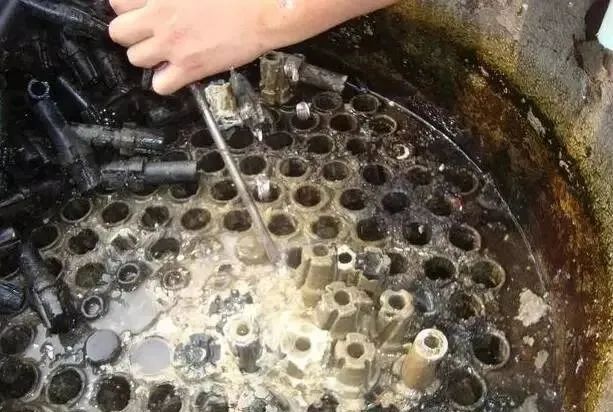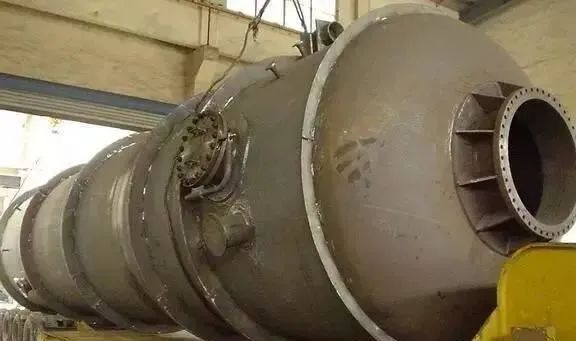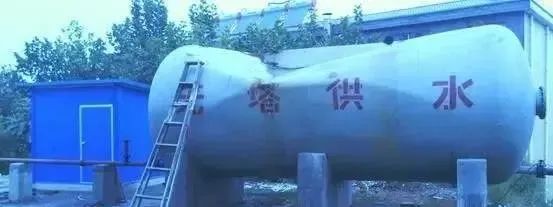The defects often encountered by pressure vessels in chemical plants are corrosion, cracks and deformation, and operators must regularly carry out technical inspections to eliminate hidden dangers as soon as possible to prevent defects from continuing to develop and expand, affecting production.
1. Corrosion

Corrosion is one of the most likely defects in the use of pressure vessels, especially in chemical vessels. It is caused by chemical or electrochemical changes between the metal and the medium it is in contact with.
Corrosion type:
Corrosion of containers can be uniform corrosion, point corrosion, intergranular corrosion, stress corrosion and fatigue corrosion. No matter which kind of corrosion, severe will lead to the failure or destruction of the container.
Corrosion can occur on both internal and external surfaces of pressure vessels. The outer wall of the container is generally the corrosion of the atmosphere, the corrosion of the atmosphere is closely related to the region and the season, etc. In the dry area or season, the corrosion of the atmosphere is much less than that in the wet area or rainy season.
The corrosion of the outer wall of the pressure vessel occurs in the parts that are often in a wet state and easy to accumulate water or moisture. The contact surface between the container and the support, and the part of the container in contact with the ground are prone to corrosion. The corrosion of the inner wall of the container is mainly caused by the action of the working medium or the impurities it contains. In general, containers with obvious corrosive effects of the working medium are designed with anti-corrosion measures, such as the selection of corrosion-resistant materials, surface treatment or surface coating, lining on the inner wall, etc. Therefore, the corrosion of the inner wall of these containers is often caused by the destruction of anti-corrosion measures.
The corrosion of the inner wall of the container may also be caused by the destruction of normal process conditions, such as dry chlorine does not have a corrosive effect on the steel container, and if the chlorine gas contains water or the container filled with chlorine gas does not dry after the water pressure test, or enters the water for other reasons, the chlorine gas reacts with water to form hydrochloric acid or hypochlorous acid, which has a strong corrosive effect on the inner wall of the container.
Corrosion can also be caused or aggravated due to structural reasons, for example, a container with corrosive sediment, the discharge pipe is higher than the bottom plane of the container, so that the bottom of the container long-term accumulation of corrosive sediment, resulting in corrosion.
In addition, welds and heat-affected zones, around the rivet of the riveted container and the joint zone are more prone to corrosion.
Because the corrosion of the outer wall of the container is generally uniform corrosion or local corrosion, it can be found by visual inspection. If the outer wall is coated with a paint protective layer of containers, if the protective layer is intact, and no other suspicious signs are found, it is generally not necessary to remove the protective layer to check the corrosion of the metal wall.
For containers with insulation or other covering layers outside, if the insulation material has no corrosion effect on the wall material, or the container shell has an anti-corrosion layer, the insulation layer can be not removed if the insulation layer is intact, but if leaks or other signs that may cause corrosion are found, at least part of the insulation layer is removed in the suspicious place for inspection.
There may be various forms of corrosion on the inside of the container. Uniform corrosion and local corrosion can also be visually inspected. For intergranular corrosion and fracture corrosion (stress corrosion and fatigue corrosion), in addition to serious intergranular corrosion can be found by hammering inspection, it is generally difficult to judge by visual inspection, commonly used metallographic inspection, chemical composition analysis and hardness determination. The general lining should be inspected for air tightness, and the components that hinder the inspection should be removed during the inspection.
After visual inspection, it is found that there is uniform corrosion or local corrosion on the inner wall or outer wall of the container, the remaining thickness of the corroded place should be measured, so as to determine the corrosion thickness and corrosion rate of the wall.
Treatment method:
The treatment of corrosion defects depends on the specific use of the container, and the general principles are:
(1) When intergranular corrosion, fracture corrosion and other defects are found on the inner wall, it is not easy to continue to use. If the corrosion is slight, it is allowed to use under changed operating conditions according to the specific situation.
(2) When the dispersion point corrosion is found, but does not hinder the process operation (there is no crack, the corrosion depth is less than half of the calculated wall thickness), the defect can continue to use without treatment.
(3) According to the principle that the remaining thickness of uniform corrosion and local corrosion is not less than the calculated thickness, it is determined to continue to use, reduce the inspection interval period, reduce pressure use or reject.
2. Cracks

Crack is one of the most dangerous defects in the pressure vessel, it is the factor that leads to brittle failure of the vessel, but also promotes fatigue fracture and corrosion fracture.
Crack type:
Cracks in pressure vessels, according to their generation process, can be roughly divided into two categories, that is, cracks generated in the manufacture of raw materials or containers and cracks or expanded cracks generated during the use of containers. The former includes rolling cracks of steel plate, drawing cracks of container, welding cracks and stress relief heat treatment cracks. The latter includes fatigue cracks and stress corrosion cracks.
Rolling cracks of raw materials are linear defects caused by the accumulation of defects such as porosity, shrinkage and non-metallic inclusions in metal materials. This defect can be in the interior of the material, but also on the surface, without a certain direction and fixed parts. Similar cracks are often found in some drawn small high-pressure vessels.
Welding cracks are mainly generated in the process of container manufacturing, which is due to the container manufacturer's quality inspection is not strict, or the original defect is slightly not found and has developed in the process of use.
Stress relief heat treatment crack is a kind of branched intergranular crack, which is generated during post-weld stress relief heat treatment, and can also be extended in use.
Fatigue cracks are caused by the poor structure of the container or the defects of the material, resulting in excessive local stress, cracks caused by repeated pressure or pressure relief of the container, and such cracks can be found in some pressure vessels that open and stop frequently.
Corrosion cracks are gradually formed when the corrosive medium corrodes the material under certain working conditions, and this crack is often related to stress. Because stress and corrosion promote each other, the latter forms a notch on the surface of the material to produce stress concentration, or weaken the intergranular bonding force of the metal, while the former accelerates the progress of corrosion, so that the surface notch develops deeper.
Although the cracks of the pressure vessel may exist in various parts of its internal and external surfaces, the places that are most likely to produce cracks are welds and welding heat affected zones and the parts where the local stress is too high.
Treatment method:
Cracks can be inspected by visual inspection and non-destructive testing. Generally, signs of cracks are found or initially found through visual inspection, and then further confirmed by non-destructive testing. Non-destructive testing, whether it is liquid penetration testing, fluorescent testing and magnetic testing, has a high effect on the inspection of surface cracks, and can be selected appropriately according to the specific situation.
When the pressure vessel is found to have a crack defect, the cause of the crack should first be analyzed according to the crack location, quantity, size, distribution and working conditions of the container, etc., and metallographic inspection can be carried out if necessary to determine whether the crack is a defect in the raw material, or left during the manufacture of the container, or generated during the use of the process. Then, according to the severity of the defect and the specific situation of the container, the defect or the container treatment method for the defect is determined.
Due to the micro-cracks left by the material rolling or drawing containers, they are generally relatively shallow and can be ground away with hand files or grinding wheels. Welding cracks should be removed when found by inspection.
Parts with cracks due to poor structure and excessive local stress are generally not suitable for continued use. Containers with corrosion cracks should not be removed or repaired after welding.
In special cases, because the cracks left by the container manufacturing or raw materials are indeed difficult to eliminate, after the inspection and identification of the qualified pressure vessel defect assessment unit, and according to the analysis and calculation of fracture mechanics, it is confirmed that the cracks will not expand, and there is sufficient safety margin, the container can take reliable monitoring measures and continue to use, but to shorten the inspection interval period. Closely monitor the development of cracks.
3. Deformation

Deformation refers to the geometric shape of the container changed in the whole or local place after use, and this defect is generally rare in pressure vessels.
Crack type:
- The deformation of containers can be generally shown as local depression, bulging, overall flat, overall expansion and other forms.
Local depression is the surface depression caused by the impact or extrusion of the local area of the container shell or head by external forces. This deformation can only be produced on the small container with thin shell walls. It does not cause the change of the wall thickness of the container, but only causes a local surface to lose its original geometry.
Bulge is a part of the pressure surface of the vessel due to serious corrosion, the wall thickness is significantly reduced, so that the external bulge deformation occurs under the action of internal pressure. In individual cases, the local temperature of the container can also be too high, resulting in the mechanical properties of the material to reduce the bulge, and this deformation will further reduce the wall thickness of this area of the container.
The overall flat flat is because the wall thickness of the shell under external pressure is too thin, so that it loses stability under pressure and loses the original shell shape. This deformation only occurs in the external pressure parts of the container, such as the inner cylinder of the jacket container.
The overall expansion deformation is caused by the thickness of the container wall is too thin or overpressure is used, resulting in the yield deformation of the entire container or some sections. This deformation is generally slow and can only be detected under special monitoring.
Treatment method:
- The inspection of deformation can be generally used for visual inspection, and less serious deformation can be found by measuring tool inspection.
Containers with deformation defects, except for less serious local depressions, are generally not suitable for continued use. Because of the plastic deformation of the container, the wall thickness is always reduced to different degrees, and the deformed material will also reduce the toughness due to strain hardening, and the corrosion resistance is poor.
For slight bulging deformation, if the deformation area is not too large, and does not affect the other parts of the container, in the case of good solderability of the container material, the repair treatment can be considered. That is, the part of the local bulge is dug out, and then the plate with the same shape and material is repaired, and the weld is inspected according to the original technical requirements of the container after welding.






